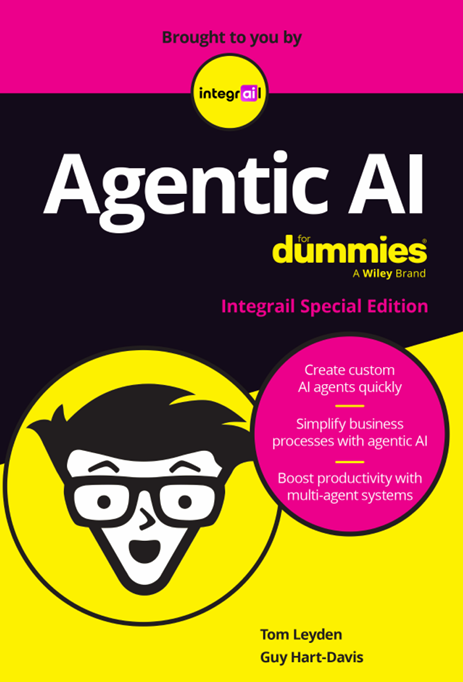Agentic AI for Dummies: Transform Your Business Automation
If you’re hearing about Agentic AI and wondering what all the fuss is about, you’re not alone. It sounds complex, but here’s the good news: it’s...
Learn how Multi-Agent Systems (MAS) revolutionize AI by solving complex problems with diverse agents across industries like robotics, finance, and more.
Multi-Agent Systems (MAS) are rapidly transforming the landscape of artificial intelligence, offering powerful solutions for complex problems across various industries. From robotics to finance, MAS leverage the collaborative power of multiple intelligent agents to achieve goals that would be impossible for a single agent alone. In this comprehensive guide, we'll delve into the diverse types of MAS, exploring their unique characteristics, applications, and potential impact.
What are Multi-Agent Systems?
At its core, a multi-agent system is a network of autonomous agents that interact with each other and their environment to solve complex problems or achieve common objectives. These agents can be software programs, robots, or even humans. The key lies in their ability to communicate, cooperate, coordinate, and sometimes compete to accomplish tasks that require collective intelligence.
Types of Multi-Agent Systems
1. Reactive Agents: Reactive agents are the simplest type of MAS agents. They operate based on a set of pre-defined rules, reacting directly to their current environment without considering past experiences or future consequences. Think of them like reflex responses. These agents are commonly found in video game AI, where characters react to the player's actions in real time.

Imagine a video game where the player navigates through levels filled with enemy characters. These enemies are controlled by reactive agents that respond to the player's actions in real time.
Player Detection:
Attack Response:
Movement Patterns:
Defense Mechanisms:
Environmental Interaction:
The reactive agent provides a challenging but predictable adversary for the player. Its rule-based behavior ensures consistent and immediate responses, creating a dynamic and engaging gameplay experience.
Reactive agents, with their predefined rule-based behavior, are fundamental components in many video games. They provide real-time responses to player actions, ensuring a responsive and engaging gaming experience. Although simple, these agents play a crucial role in creating dynamic and interactive environments.
2. Deliberative Agents: Unlike reactive agents, deliberative agents possess a higher level of intelligence. They maintain an internal model of the world, plan their actions, and make decisions based on reasoning and logical deduction. These agents are often employed in complex planning scenarios, such as autonomous vehicle navigation or resource allocation in supply chains.

Imagine an autonomous vehicle navigating through a busy city. This vehicle is controlled by a deliberative agent that makes intelligent decisions based on a comprehensive understanding of its environment.
Environmental Mapping:
Route Planning:
Decision Making:
Predictive Modeling:
Adaptation:
The deliberative agent enables the autonomous vehicle to navigate safely and efficiently through the city, making intelligent decisions that mimic human-like reasoning and adaptability.
Deliberative agents, with their advanced planning and reasoning capabilities, are essential for tasks that require complex decision-making and adaptability. In the context of autonomous vehicle navigation, they enable safe, efficient, and intelligent transportation by continuously evaluating and responding to the environment. Their ability to maintain an internal model and make decisions based on logical deduction makes them invaluable in various high-stakes applications.
3. Hybrid Agents: Hybrid agents combine the best of both worlds, blending reactive and deliberative elements. They might utilize reactive behaviors for immediate responses while relying on deliberative processes for long-term planning. This approach is often seen in robotics, where robots need to react quickly to obstacles while also navigating towards a predetermined goal.

Imagine a robotic system managing inventory in a large warehouse. These robots are controlled by hybrid agents that combine reactive and deliberative behaviors to efficiently and safely navigate the environment, manage inventory, and fulfill orders.
Obstacle Avoidance:
Navigation and Path Planning:
Inventory Management:
Collaborative Tasks:
Charging and Maintenance:
Hybrid agents enable the warehouse robots to operate efficiently and safely, combining quick reflexes for immediate challenges with strategic planning for overall operational efficiency.
Hybrid agents are essential in environments where both quick reflex actions and strategic planning are necessary. In robotic warehouse management, they ensure efficient navigation, inventory management, and task fulfillment by combining reactive behaviors for immediate responses with deliberative processes for long-term planning. This dual approach enables robots to operate safely and efficiently in dynamic, complex environments.
4. Cooperative Agents: In cooperative MAS, agents work together harmoniously to achieve a shared objective. They communicate, share information, and coordinate their actions to maximize collective performance. Cooperative agents are essential in fields like disaster response, where multiple robots or drones collaborate to search for survivors or deliver supplies.

Imagine a natural disaster, such as an earthquake, where multiple robots and drones are deployed to search for survivors and deliver essential supplies. These robots and drones are controlled by cooperative agents that work together to achieve the common goal of saving lives and providing aid.
Search Operations:
Survivor Detection and Rescue:
Supply Delivery:
Environmental Monitoring:
Adaptive Strategy:
Cooperative agents significantly enhance the effectiveness of disaster response efforts. By working together harmoniously, they can cover larger areas more quickly, optimize resource allocation, and increase the chances of finding and rescuing survivors.
Cooperative agents are crucial for scenarios requiring collective effort and synchronized actions, such as disaster response and search-and-rescue operations. Their ability to communicate, share information, and coordinate tasks ensures that they can effectively and efficiently achieve their shared objectives. This cooperative approach maximizes performance and enhances the overall success of complex missions in dynamic and challenging environments.
5. Competitive Agents: Unlike cooperative agents, competitive agents strive to outperform each other to achieve individual goals. This type of MAS is prevalent in gaming, where players compete for resources or territory. It's also found in financial markets, where trading algorithms engage in fierce competition to maximize profits.

Imagine a stock exchange where multiple trading algorithms (agents) are operating simultaneously. Each algorithm is designed by different financial firms to maximize their own profits by buying and selling stocks in a highly competitive environment.
Market Analysis:
Order Execution:
Competitive Tactics:
Learning and Adaptation:
Risk Management:
Competitive agents in financial markets drive rapid trading activity and liquidity but also increase market complexity and volatility. Each algorithm strives to maximize its own profits, often leading to highly dynamic and sometimes unpredictable market behavior.
Competitive agents play a critical role in environments where individual success is paramount, such as financial markets and gaming. Their strategic and adaptive behavior allows them to outcompete others and achieve their goals, driving market dynamics and innovation. While their actions can enhance market efficiency, they also contribute to increased complexity and volatility, highlighting the need for effective regulation and risk management.
6. Learning Agents: Learning agents have the remarkable ability to adapt and improve their performance over time through experience. They can learn from their successes and failures, adjusting their strategies to become more effective. Machine learning techniques, such as reinforcement learning, are often employed to train these agents.

Imagine a personal assistant software that helps users manage their daily schedules, prioritize tasks, and provide recommendations. This assistant is controlled by a learning agent that continuously adapts to the user's preferences and behaviors to provide more relevant and efficient assistance.
User Behavior Analysis:
Task Prioritization:
Personalized Recommendations:
Schedule Management:
Continuous Improvement:
The learning agent becomes increasingly effective at managing the user’s schedule, prioritizing tasks, and providing recommendations. Over time, it learns the user’s preferences and adapts to their changing needs, offering a highly personalized and efficient assistant experience.
Learning agents bring significant benefits to applications requiring continuous adaptation and improvement, such as personal assistant software. By leveraging machine learning techniques, these agents can learn from experience, adjust their strategies, and provide increasingly effective and personalized assistance. Their ability to adapt and improve over time makes them invaluable in dynamic and user-centric environments.
7. Selfish Agents: Selfish agents prioritize their own goals over the collective good. They may even deceive or manipulate other agents to gain an advantage. While not inherently cooperative, selfish agents can be beneficial in MAS designed to model real-world scenarios where competition exists alongside collaboration.

Imagine an online marketplace where multiple agents, representing different buyers, are bidding for a limited number of high-demand products. Each agent aims to secure the best possible deal for its owner, who could be an individual consumer or a business.
Market Analysis:
Bid Placement:
Deception and Manipulation:
Timing the Final Bid:
Adaptive Strategy:
The selfish agent successfully secures the product by outmaneuvering other agents through strategic bidding and competitive tactics. Its actions ensure that it achieves its owner’s goal, often at the expense of fair play or collective benefit within the auction system.
While the selfish agent achieves its individual objective, its aggressive and manipulative tactics can lead to:
This example demonstrates how a selfish agent operates within a multi-agent environment, focusing solely on its own goals and employing various strategies to outcompete others.
8. Socially Aware Agents: Socially aware agents take social cues and environmental factors into account when making decisions. They can understand the intentions and motivations of other agents, which allows them to collaborate more effectively and navigate complex social interactions. Socially aware agents are being explored for applications in human-robot interaction and online marketplaces.
Scenario: Online Marketplaces

Setting: Imagine an online marketplace where buyers and sellers interact. These interactions are facilitated by socially aware agents that help ensure fair transactions and enhance user experience.
Characteristics of Socially Aware Agents:
Actions of Socially Aware Agents:
User Interaction:
Market Dynamics:
Collaborative Filtering:
Environmental Adaptation:
Outcome: Socially aware agents create a more user-friendly and efficient online marketplace by understanding and responding to the social dynamics of user interactions. They enhance the user experience by providing personalized assistance, fostering trust, and ensuring fair transactions.
Impact on the System:
Example Process for Socially Aware Agents:
Socially aware agents are crucial for applications that involve complex social interactions and collaboration. By understanding social cues and environmental factors, these agents can navigate interactions more effectively, leading to enhanced user experiences and more efficient systems.
9. Benevolent Agents: Benevolent agents prioritize the well-being of others and act in a way that benefits the entire system. They may sacrifice their own goals to some extent for the greater good. Benevolent agents are being researched for use in MAS designed to address global challenges like climate change or resource management.

Imagine a multi-agent system deployed to manage a large forest area to mitigate climate change and ensure sustainable resource management. These agents are programmed as benevolent agents that prioritize the health of the ecosystem and the well-being of the community relying on it.
Forest Health Monitoring:
Sustainable Resource Management:
Fire Prevention and Response:
Community Engagement:
Biodiversity Conservation:
Climate Change Mitigation:
Benevolent agents help maintain the health and sustainability of the forest ecosystem, balancing the needs of the environment with those of the local community. Their actions contribute to long-term climate change mitigation and resource sustainability.
Benevolent agents are crucial for addressing large-scale challenges that require a focus on the common good, such as climate change and resource management. Their selfless approach ensures that actions are taken for the benefit of the entire system, leading to sustainable and equitable outcomes. By prioritizing the well-being of others and the environment, benevolent agents play a vital role in creating a more sustainable and resilient future.
10. Homogeneous vs. Heterogeneous Agents:
MAS can be classified based on the uniformity of their agents. Homogeneous MAS consist of agents with identical capabilities and behaviors. Heterogeneous MAS, on the other hand, involve agents with diverse skillsets and functionalities. Heterogeneous MAS are often more complex to design but offer greater flexibility and problem-solving potential.

Consider a smart city implementing a traffic management system to optimize traffic flow, reduce congestion, and enhance safety. The system utilizes a Multi-Agent System (MAS) where traffic signals, autonomous vehicles, and surveillance drones act as agents.
Traffic Signal Coordination:
Vehicle Navigation:
Surveillance and Reporting:
Homogeneous MAS provide a straightforward and reliable system for traffic management, ensuring consistency and predictability. However, they may lack the flexibility to handle highly dynamic or complex scenarios.
Traffic Signal Coordination:
Vehicle Navigation:
Surveillance and Reporting:
Heterogeneous MAS offer a flexible and robust traffic management system capable of handling complex and dynamic urban environments. The diverse capabilities of agents allow for specialized tasks and improved overall efficiency, but require sophisticated coordination and integration.
Homogeneous MAS:
Heterogeneous MAS:
The choice between homogeneous and heterogeneous MAS depends on the complexity and requirements of the application. Homogeneous MAS are suitable for simpler, more predictable environments, offering ease of implementation and consistency. In contrast, heterogeneous MAS excel in dynamic and complex scenarios, providing flexibility and enhanced problem-solving capabilities at the cost of increased design and coordination complexity.
Multi-agent systems (MAS) offer a new frontier in artificial intelligence. By leveraging the power of cooperation among multiple intelligent agents, these systems are set to tackle intricate problems that single agents can't handle alone. From making our cities smarter by managing traffic flow more efficiently, to enhancing healthcare with personalized insights, MAS have the potential to change how we live and work.
As research and development in this field accelerate, we anticipate even more impressive applications. Imagine a future where teams of robots collaborate to construct eco-friendly buildings or virtual assistants work together to deliver customized learning experiences for each student. The possibilities are truly exciting.
Understanding the various types of MAS and their individual advantages is essential to harnessing their full potential. Through thoughtful design and implementation, we can create a future where collaborative AI leads to innovation, streamlined processes, and solutions for challenges that previously seemed out of reach.

If you’re hearing about Agentic AI and wondering what all the fuss is about, you’re not alone. It sounds complex, but here’s the good news: it’s...

Artificial Intelligence (AI) is rapidly evolving, and one of the most exciting advancements is the emergence of agentic AI. But what exactly is it,...

Businesses are constantly seeking ways to improve efficiency and streamline operations. One innovative approach gaining traction is multi-agent...
Start your journey with Integrail

Try AI Studio by Integrail FREE and start building AI applications without coding.

NEW White Paper: Discover how AI Studio accelerates your workflows